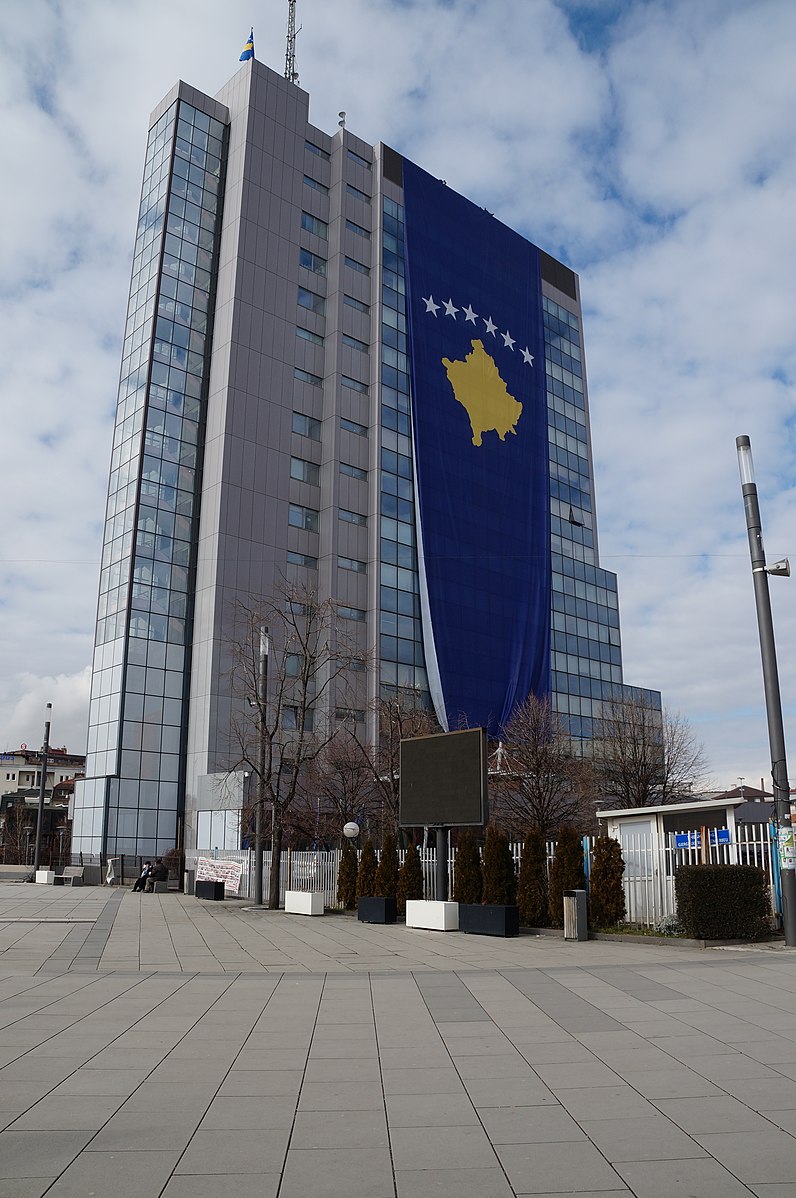U.S. Interests in Negotiations Between Serbia and Kosovo
A war crimes indictment stymied scheduled U.S.-hosted talks between Kosovo and Serbia. What’s the U.S.’s diplomatic interest in the negotiations?

Published by The Lawfare Institute
in Cooperation With

The Kosovo-Serbia conflict ended formally on June 20, 1999, but tensions have nonetheless percolated from time to time in the intervening 21 years. The journey to a permanent resolution to the conflict faced another roadblock a few weeks ago when Kosovar President Hashim Thaci was indicted on war crimes stemming from Thaci’s actions during the war between Kosovo and Serbia that occurred in the late 1990s over Kosovo’s efforts to secede from Serbia.
The charges come from the Kosovo Specialist Chambers and the Specialist Prosecutor’s Office, a prosecutorial body set up through Kosovo’s parliament. The Kosovar legislature intended for this body to have jurisdiction over atrocities committed during the Kosovo-Serbia conflict between January 1998 and December 2000. Thaci was indicted for a “range of crimes against humanity and war crimes, including murder, enforced disappearance of persons, persecution, and torture,” which occurred during the conflict.
The indictment came right before Thaci was scheduled to come to the White House to meet with Serbian leaders to discuss how to end the conflict. Thaci’s indictment further complicates an already messy situation. The U.S.’s role in the talks between Kosovo and Serbia has attracted scorn from EU leaders. And the U.S.’s relationship with Kosovo remains complicated, as it seeks to balance support for Kosovo with other regional interests—namely, avoiding antagonizing Serbia due to Serbia’s close relationship with Russia.
The indictment has important implications for U.S. diplomatic involvement in the region and highlights the complexities of the U.S. role in the Balkans.
Initial U.S.-Kosovo Relations
The U.S. has been a staunch ally of Kosovo and has worked to find a permanent resolution to the conflict. But U.S. ties to Kosovo have become strained recently. While the U.S. has been loyal to Kosovo, it has not been afraid to criticize the country, putting some strain on the relationship between the U.S. and its Balkan ally.
The Kosovo government has long had a deep loyalty toward the United States. The country’s connection with the U.S. comes from President Clinton’s decision to intervene in the Kosovo-Serbia conflict. The 1999 intervention came as an attempt to thwart a genocide against the Kosovar people led by then-Serbian President Slobodan Milosevic. Milosevic had aimed to take Kosovo’s land and ensure that Kosovo could not secede from Serbia. NATO intervention famously included airstrikes against Serbia. Following the end of the conflict in the former Yugoslavia, the U.S. worked in the U.N. Security Council throughout the 2000s to try to help Kosovo receive an endorsement of independence from the council.
When it became clear that U.S. efforts had failed, Kosovo unilaterally declared its independence in February 2008. The U.S. was one of the first nations to recognize Kosovo as a state after it declared its independence, and the U.S. has continued to urge the international community to recognize Kosovo’s independence. Serbia has refused to do so and still considers Kosovo part of Serbia.
After Kosovo declared independence, the U.S. and EU wanted Kosovo and Serbia to hold talks to resolve their differences. Kosovo’s government initially insisted on a U.S. presence at talks with Serbia, which resulted in a delay in the talks because Serbia mistrusted the U.S. over its role in the 1999 conflict.
Talks eventually began in September 2011, but they went on without a U.S. presence and were mediated instead by the EU. The 2011 meetings failed to establish an agreement on the status of Kosovo. Even after the close of the meetings, it was unclear whether Kosovo was formally its own nation or part of Serbia.
Since then, the U.S. has continued to encourage Kosovo and Serbia to negotiate. U.S. efforts were met with some resistance from Kosovars in February 2016, when many Kosovars accused the U.S. of using its influence to try to convince Kosovo to give up some sovereignty. At that time, Kosovars were frustrated with their government leaders’ problems with corruption. As a result, many Kosovars did not trust their leaders to maintain Kosovo’s sovereignty in negotiations with Serbia and were concerned that the U.S. would push their government leaders into an agreement that would not be in Kosovo’s interests.
Background on the U.S.-Led Summit
Even as past talks failed, Kosovo continued to try to assert itself as a state. In March 2017, Kosovo floated the idea of creating its own military, but both NATO and the U.S. opposed the plan, largely out of fear that it would amplify tensions with Serbia. However, in December 2018, the U.S. made an about-face and announced its support for Kosovo to create a military, a move that angered Serbia. At the same time, President Trump also made an overture toward Kosovo and urged them to reach a deal with Serbia.
Trump’s plan for a deal did not succeed then, and tensions between the two Balkan countries continued to increase. Kosovo, for example, hit Serbia with 100 percent tariffs due to Serbia’s refusal to recognize Kosovo as a state. In March 2019, the U.S. called on Kosovo to lift these tariffs, but its calls went unanswered for more than a year. In February 2020, Kosovo issued a preliminary halt on the tariffs, but the halt applied only to raw materials from Serbia. Kosovo said it would fully lift the tariffs if Serbia stopped intervening in Kosovo’s effort to be fully recognized as a state. The EU praised Kosovo’s partial halt on the tariffs, but the U.S. claimed that the hold did not go far enough and that Kosovo needed to lift the tariffs completely.
Kosovo’s resistance to fully lift the tariffs was due at least partially to Kosovo’s February 2020 election of left-wing Prime Minister Albin Kurti. The new prime minister ran on a promise of shaking up the government and improving Kosovo’s standing as an independent state. And on Feb. 27, he announced the partial tariff cut on raw materials from Serbia and pledged that if Serbia lifted its restrictions on imports from Kosovo, then all tariffs on Serbian goods would be lifted.
But Kurti’s tenure in office was short lived. Several of the parties in Kurti’s coalition government lost faith in his ability to lead and pulled out of the government, which caused Kurti’s government to collapse. On June 3, the leading center-right party, the Democratic League of Kosovo, seized the opportunity and convinced a majority of the parliament to elect their candidate, Avdullah Hoti, as prime minister. Upon taking office, Hoti vowed to normalize ties with the U.S., EU and Serbia, which the Kosovo tariffs had strained.
With a more flexible government in power in Kosovo, U.S. Presidential Envoy Richard Grenell announced in June that he had organized a summit between Kosovo and Serbia leaders. The announcement angered some EU allies because many who had long worked for an agreement between Serbia and Kosovo felt they were being cut out of the process—the EU spent a long time building the groundwork for the deal, and some allies believed that Grenell came in after doing little work of his own and tried to force a deal through.
Prior to the announcement of the summit, Grenell had already claimed that he had brokered three small agreements between Kosovo and Serbia regarding transportation. However, EU experts claimed that Grenell actually had Serbia and Kosovo sign different texts for each of the three agreements. EU experts also noted that the subjects Grennell had claimed his agreements resolved were all questions the EU had already mediated successfully. There was also concern from EU countries that Grenell had been too aggressive with Kosovo in trying to get its leaders to lift the tariffs on Serbia. Given these issues, many foreign policy experts warned that the planned White House talks would fail and considered the talks dangerous.
However, concerns about the U.S. summit became moot when Thaci was indicted. After the indictment, both Thaci and Hoti canceled their participation in the White House summit. Instead of rescheduling the U.S. summit, Kosovo and Serbia agreed to participate in a virtual summit led by France and Germany that took place on July 10. The conference did not lead to any new substantive agreement, but it did put the EU back in control of the talks, and further EU mediated talks are planned. EU foreign policy chief Josep Borrell declared that “the European Union is back in the driver’s seat of the process,” likely an implicit swipe at Grenell’s handling of the talks.
While the issue of Kosovo-Serbia relations has always been contentious, Grenell’s aggressive tactics did not help to diffuse the situation. The long-term effects of Grennell’s attempted diplomatic intervention remain to be seen.
Where Russia Comes In
Russia has remained a staunch ally of Serbia since NATO intervened in the Kosovo-Serbia conflict. Russia condemned NATO intervention as “an illegal military action.” Over the past few decades, Russia has continued to keep Serbia as an ally. Motivated by its links with Russia, Serbia has been careful to keep close ties with the U.S. and the EU. But it has also never fully embraced its relationship with Russia.
Serbia’s balanced relationship with the U.S. and Russia has caused discontent with both countries.
Because Serbia refuses to recognize Kosovo, the EU has made it clear that it will not let Serbia join the union. And Kosovo’s lack of international recognition makes it impossible for it to join the EU as well. Russia has taken advantage of Serbia’s inability to make progress on joining the EU by courting Belgrade with an array of economic and military benefits that the Balkan country cannot receive from the EU. In August 2019, Serbia angered the EU by agreeing to a trade pact with Russia, ignoring EU warnings. EU leaders even warned that Serbia’s actions could threaten Serbia’s path to joining the EU.
The U.S. has also had its challenges navigating Serbia’s relationship with Russia during the past few years. In November 2019, the U.S. announced its frustration with Serbia for continuing to buy weapons from Russia, arguing that the purchases undermined sanctions that the U.S. had against Russia. But Serbia continued to purchase weapons from Russia over the following few months, leading the U.S. to threaten sanctions against Serbia.
A mix of diplomatic controversies surrounding Grennell’s summit help to illustrate the complicated web of relationships in this space. Serbia angered Russia when it decided to join the summit that Grenell had organized. However, Russia aimed its frustration toward the U.S. rather than Serbia. Russia Foreign Affairs Minister Sergey Lavrov even promised that Russia would “advocate such approaches that will not infringe on the interests of Serbia” and reiterated Russia’s view that Serbia “plays an important and positive role in ensuring peace and stability in the region at this stage.” Serbia stated that any agreement with Kosovo would be subject to Russia’s approval.
And what’s Russia’s interest in Serbia in the first place? Russia’s actions stem largely from its desire to maintain and expand its influence in Eastern Europe. Russia has sought to undermine U.S. and EU actions in Eastern Europe over the past decade and has had mixed results. However, Serbia has remained loyal to Russia, and the Kremlin does not want to lose its ties to Belgrade. The U.S. and EU disagreement over how to best resolve the Kosovo-Serbia conflict has created an opening for Russia to intensify divisions.
What can the U.S. do to counter Russian influence in the region?
There are many open strategic questions, but experts largely agree that progress on the conflict and the successful integration of Serbia into the EU is important for checking Russia’s power in the region.





